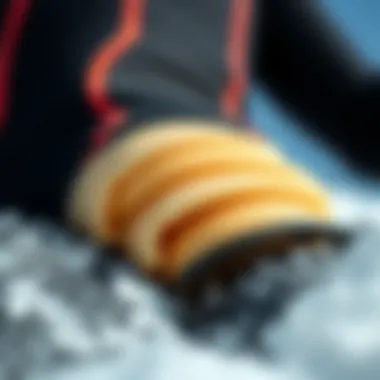Understanding Wetsuit Thicknesses for Kiteboarding


Intro
When it comes to kiteboarding, comfort and safety are non-negotiable, especially when the water temperatures start to dip. A crucial piece of equipment that can make or break your kiteboarding experience is the wetsuit. But not all wetsuits are created equal, and understanding wetsuit thickness is paramount for anyone serious about their time on the water.
Choosing the right wetsuit thickness isn't just about staying warm. It's also about achieving a balance between insulation and flexibility, both of which can hinge on how well you perform out there. Whether you're a kiteboarding novice embarking on your first lessons or a seasoned rider tackling more advanced maneuvers, this guide aims to arm you with the knowledge needed to select the best wetsuit for your needs.
Wetsuit thicknesses vary significantly, influenced by factors such as water temperature, individual tolerance to cold, and the type of kiteboarding you engage in. In the following sections, we'll dive deeper into the complexities of wetsuit selection, explore the nuances of various thicknesses, and offer practical advice on how to maintain your wetsuit for longevity. Plus, we’ll touch upon how a properly fitting wetsuit can contribute to a superior kiteboarding experience.
So, let’s plunge into the specific factors that determine the right wetsuit thickness and why it matters in the world of kiteboarding.
Foreword to Wetsuit Thicknesses
In the world of kiteboarding, the role of wetsuits cannot be overstated. These garments not only provide warmth but also ensure safety and comfort during those exhilarating rides across the water. Understanding wetsuit thicknesses is essential for kiteboarders of all levels, as it directly influences the riding experience—whether you're gliding over calm waters or facing tumultuous waves.
A wetsuit acts as a barrier against the elements, helping to maintain core body temperature and protect against the chills of colder waters. When temperatures dip, a surfer’s performance can drop too. Without proper insulation, muscle function diminishes and fatigue sets in quicker. Thus, selecting the right wetsuit thickness can spell the difference between a few blissful hours on the waves or an uncomfortable, shivering session.
Equally important to consider when diving into wetsuits is the element of flexibility. While a thicker suit may provide more warmth, it can also restrict movement. An agile kiteboarder needs to balance insulation and mobility to perform tricks and manage their board effectively.
When considering these factors, comprehension of thickness measurement is essential. Wetsuit thickness is typically denoted in millimeters and varies from very thin shorty suits to thicker full-body offerings. This guide will navigate the various thicknesses available, how they cater to different temperature ranges, and why understanding your local water conditions can equip you with the insights needed to make an informed choice.
To take it a step further, factors such as water temperature, duration of exposure, and personal comfort preferences play a crucial role in selecting the appropriate wetsuit thickness. Taking the time to evaluate these elements not only helps kiteboarders select a wetsuit tailored to their needs but also unravels the connection between suit choice and performance on the water. Fundamentals here are much like the foundation of a building; neglecting to identify the right thickness could lead to a shaky experience when you hit the surf.
"A kiteboarder's affinity for the water is as sensitive as the wetsuit they choose. Make your choice wisely."
Ultimately, this article aims to enlighten readers on the science and practicality behind wetsuit thicknesses. It aspires to turn kiteboarding enthusiasts into informed decision-makers, armed with comprehensive knowledge to enhance their time spent on the water.
Wetsuit Thicknesses Explained
When it comes to kiteboarding, knowing about wetsuit thicknesses isn’t just a trivial detail; it’s a cornerstone of comfort and performance. Selecting the right thickness can make or break a kiteboarder’s experience on the water. A wetsuit that’s too thin for the water temperature can lead to discomfort or even hypothermia, while a suit that’s overly thick can restrict movement, negating agility during maneuvers. Thus, understanding the ins and outs of wetsuit thickness is essential for any serious kiteboarder.
Common Thickness Measurements
Wetsuit thicknesses are typically measured in millimeters and vary across different sections of the suit. Most commonly, you’ll find measurements like 3/2 mm or 4/3 mm, where the numbers indicate the thickness of the neoprene used in the core versus the limbs.
- 3/2 mm: This type of wetsuit is great for warmer waters, as the torso is well insulated while the arms and legs have less thickness, allowing for greater flexibility and freedom of movement.
- 4/3 mm: In cooler conditions, a 4/3 mm wetsuit offers more insulation, providing ample warmth to the body while still maintaining reasonable flexibility.
- 5/4 mm: For colder climates, these suits come with extra thickness and might feature sealed seams to minimize water entry, ensuring that the rider stays warm even in frigid waters.
The choice of thickness often boils down to local conditions and individual comfort. A rider must weigh the balance between warmth and mobility. Furthermore, suits can also come in various styles, including shorties for warmer weather or full-body wetsuits for extensive cold exposure. It’s all about selecting the right tool for the job.
Differences in Thickness Ratings
Thickness ratings might seem straightforward, but there’s a bit of nuance to consider. Not every brand uses the same materials or technologies, which can lead to variations in insulation effectiveness even if the measurements look similar on paper.


- Material Quality: The quality of neoprene can vastly differ; higher-end materials provide better insulation without bulk, while lower-quality options might feel thicker but don’t perform as well. Brands like O'Neill and Rip Curl are known for their high-quality materials that enhance both warmth and flexibility.
- Design Features: Look for wetsuits with features like thermal linings or additional insulation. These can allow for thinner suits while still providing warmth. Wetsuits from brands such as Aqualung sometimes have special linings that trap heat more effectively.
- Seam Construction: Seams can also impact performance. Glued and blind-stitched seams, found in higher-end models, limit water entry and keep the wearer warmer than flatlock seams, which are great for warmer temperatures but less effective in retaining heat.
"Choosing the right wetsuit thickness isn’t just about staying warm; it’s about maximizing your performance on the water. A well-fitted wetsuit enhances your agility, allowing for effortless movement during kiteboarding maneuvers."
Understanding these measurements and ratings aids kiteboarders in making informed decisions. It's not just the numbers that matter, but everything behind those numbers—the materials, the designs, and how they align with a rider’s specific needs in various conditions. As such, knowing how to interpret these details will undoubtedly improve both safety and enjoyment in the sport.
Factors Influencing Wetsuit Thickness Selection
Choosing the right wetsuit thickness for kiteboarding goes beyond just picking a random fit from a rack; it’s an intricate decision influenced by various factors. Understanding these elements can not only enhance your comfort but also your performance on the water. Whether you’re a seasoned kiteboarder or just a weekend enthusiast, knowing what drives your wetsuit choice can often spell the difference between an enjoyable time on the waves and a regrettable outing.
Water Temperature Considerations
One of the most significant elements in selecting wetsuit thickness is the water temperature. Colder waters demand more insulation, which often translates to more thickness in your wetsuit. For instance, riding in frigid waters—think places where the temperature hovers around 50°F—generally requires a suit that’s 5mm thick or more. On the flip side, in warmer climes where temperatures reach about 70°F, a 3mm wetsuit might do the trick.
Water temperature affects how heat is lost from your body. When you’re submerged, your body loses heat to the cooler water, and this heat loss can become uncomfortable pretty quickly. A thicker wetsuit traps more body heat, thereby providing better insulation. However, one also needs to be cautious; going too thick in warmer waters may lead to overheating, making your kiteboarding experience unpleasant.
Duration of Exposure
Another aspect to consider is how long you expect to be in the water. If you’re planning to spend an entire day kiteboarding, opting for a thicker wetsuit may be a good idea, especially if temperatures are borderline chilly. Think of it like this: you can’t wear thin socks if you plan to stand on the cold floor all day!
Think about your typical sessions. If you're in and out of the water quickly, a thinner wetsuit might suffice. But if you intend to ride for hours at a stretch, it's wise to select something that offers ample protection against the cold, thereby ensuring your body heat remains consistent. The goal is to strike a balance that allows for prolonged enjoyment without sacrificing comfort.
Personal Comfort Preferences
Ultimately, personal comfort cannot be overstated when selecting a wetsuit. Every rider has unique body characteristics and preferences that can significantly influence the type of wetsuit they choose. Some may prefer a snug fit that comes with a thicker wetsuit, while others might feel constricted and prefer additional flexibility, even if it means sacrificing a bit of warmth.
Consider also that not everyone feels the cold the same way. If you’re someone who tends to run cold, or if you feel discomfort after a short duration in the water, it might be worthwhile to choose a thicker suit, irrespective of other factors.
Moreover, styles that incorporate additional features—like sealed seams or integrated hoods—can provide extra warmth as well. Features like these can also cater to individual tastes, allowing kiteboarders to fine-tune their levels of comfort.
"Comfort isn’t just about fit; it’s about finding the right balance between warmth and freedom of movement."
Keep an eye on local conditions and varying weather forecasts to find the perfect wetsuit that meets both your needs and the challenges that nature may throw your way. For more detailed understanding, resources like Wikipedia, Britannica, or avid kiteboarding forums on Reddit can be quite enlightening.
Types of Wetsuit Thicknesses
Wetsuits vary in thickness, each designed for different conditions and activities. Understanding these types allows kiteboarders to make informed decisions tailored to their experiences. Let`s explore the major classes of wetsuits which cater to specific needs and preferences in water sports.
Shorty Wetsuits
Shorty wetsuits, often called shorties, are perfect for warm weather kiteboarding. Typically, these wetsuits are about 2mm to 3mm thick and are designed with short sleeves and shorts, leaving the arms and legs free. This design allows for plenty of movement, making it easier to maneuver and adjust your body when riding the waves. Additionally, the minimal coverage helps to avoid overheating on sunny days while still providing some protective insulation against cooler breezes.


Consider investing in shorty wetsuits if you plan to kiteboard in warmer water, especially during the summer months. They are lightweight and easy to put on, quick to dry as well. However, keep in mind that, while they keep you comfortable from cold water, they don’t perform as well in lower temperatures. "A shorty wetsuit is like summer’s best friend; cool for the body, but warm to the touch" seems to resonate with many who’ve experienced its benefits firsthand.
Full Wetsuits
Full wetsuits offer complete coverage and are thicker than shorties, ranging from 3mm to 5mm, or more, depending on the model and intended use. Perfect for the colder months, these suits cover the entire body, including long sleeves and full legs, effectively trapping heat while allowing for freedom of movement. They excel at providing insulation against chilly waters, which makes them essential for kiteboarders who venture into colder climates or during different seasons.
A key benefit of full wetsuits is their ability to maintain body temperature. Warrior or not, many kiteboarders know that staying warm enables longer sessions on the water. You’ll often hear, "It’s not about how you catch the wind; it’s about how you ride the chill" among fellow riders. It’s a solid reminder to choose wisely based on your local conditions.
Semi-Dry Suits
Semi-dry suits are a blend of the full wetsuit’s insulation and the flexibility of other types. With a thicker construction—often around 5mm—and special sealing techniques, these suits minimize water entry, allowing for longer periods in cold waters while feeling a touch less constricting than a full wetsuit. Some kiteboarders prefer these for their snug fit, which limits water circulation while providing an adequate warmth layer.
They also boast features like back zippers and barrier cuffs designed to keep the water out, ensuring you stay dry even during lengthy kiteboarding sessions. It's like wearing a snug hug that still gives you enough room to breathe. You might say, "In every wave and gust, a semi-dry suit is a rider's armor against nature's chill subtly." If you’re serious about performance in cold conditions without the hefty weight of a full suit, semi-dry suits may be your best bet.
Choosing the right type of wetsuit thickness is crucial for any kiteboarder, as it impacts comfort, agility, and safety on the water. Explore each option, consider your local weather conditions, and choose the suit that aligns best with your thrilling escapade!
Impact of Wetsuit Thickness on Performance
Selecting the right wetsuit thickness is not just about comfort; it has a tangible impact on your performance while kiteboarding. Depending on the conditions of the water and the chosen wetsuit, the difference can be remarkable. Getting this decision just right can mean the difference between an enjoyable day on the water and one where you’re battling the elements instead of savoring them.
Flexibility vs. Insulation
When considering a wetsuit, two primary factors come into play: flexibility and insulation.
- Flexibility: This refers to how easily you can move while wearing the suit. In kiteboarding, where agility is key, a suit that allows for ample movement is important. Thinner wetsuits, often around 2mm or less, allow for greater mobility, enabling quick adjustments and stunts. However, with less material, they can only provide minimal thermal protection.
- Insulation: On the contrary, thicker wetsuits, like 4mm or 5mm, are designed to keep you warm but may limit your range of motion. Choosing the right balance between flexibility and insulation is crucial. Too thick a wetsuit can feel restrictive and dampen performance; too thin might leave you shivering and unable to focus on your ride. Striking that equilibrium can make a significant difference in how you perform.
Mobility in Various Wetsuit Types
Different styles of wetsuits affect mobility in varied ways depending on their design and intended use. Here’s a breakdown:
- Shorty Wetsuits: Ideal for warmer conditions, these suits are shorter in the legs and arms which allows for free range of movement. This is particularly beneficial when performing jumps or spins.
- Full Wetsuits: These cover the entire body and offer maximum thermal protection. While they can limit flexibility, many come with advanced designs that enhance movement, incorporating materials that stretch effectively. This way, breakdown between warmth and maneuverability is lessened.
- Semi-Dry Suits: These sit somewhere between waterproof and semi-flexible. They offer good insulation while allowing decent mobility. Kiteboarders who are out in conditions slightly cooler than pleasant but don’t want to feel gimped often go for these suits.
In summary, understanding the interplay between wetsuit thickness, flexibility, and mobility is key for kiteboarders.
"A well-chosen wetsuit that strikes the right balance allows riders not just to endure conditions, but to thrive in them."
To maximize your performance, consider not just the thickness of the suit, but also how it aligns with your kiteboarding style and the local conditions. This holistic approach ensures you remain not just warm but agile, responsive, and ready to tackle any wave that comes your way.
Tips for Choosing the Right Wetsuit Thickness
Selecting the appropriate wetsuit thickness is not just a matter of personal preference; it can impact your comfort, performance, and safety while kiteboarding. The right wetsuit helps to insulate you against the frigid waters and puts a barrier between you and the elements that might otherwise throw a wrench into your enjoyment on the waves. So, before you rush to make a purchase, it's worth considering various factors that can influence your choice and ensure that you make the most informed decision possible.


Assessing Local Conditions
When it comes to choosing a wetsuit thickness, the local climate and water temperature are paramount. Understanding these factors can mean the difference between a comfortable session and a freezing fiasco.
- Water Temperature: Measure the average water temperature where you kiteboard. The general rule of thumb suggests the thicker the wetsuit, the colder the water. For instance, if you're hitting the waves in a tropical paradise with temperatures around 24°C (75°F), a 2mm or a shorty wetsuit might do the trick. Conversely, if you're braving icy conditions closer to 10°C (50°F), look for 5mm or even thicker suits.
- Wind Factor: Remember, wind chill plays a significant role in how cold you'll feel. Wind can cut through a wetsuit and amplify the chill. Thus, even if the water is relatively warm, you might require a thicker suit on windy days.
- Seasonal Changes: The time of year matters too. In summer, you can often get away with thinner wetsuits, perhaps even sleeveless options, but as winter rolls in, you’ll likely find yourself reaching for a warmer, more insulated suit.
- Duration of Use: Those planning on long sessions may need thicker suits or even semi-dry suits, which keep the water at bay longer because they are designed to maintain warmth for extended periods. If you’re only doing quick kiteboarding bursts, you may get by with a less thick suit.
Understanding Ratings and Labels
Wetsuits come with various ratings and labels, and it can feel like navigating a maze. But deciphering these codes can be highly beneficial for selecting the right one for your needs.
- Thickness Specifications: Most wetsuits indicate their thickness in millimeters, typically shown as "2/2mm" or "4/3mm". The first number refers to the thickness of the suit in the torso, while the second one indicates the thickness in the limbs. A thicker suit in the body provides essential insulation, whereas thinner limbs ensure flexibility.
- Material Quality: Pay attention to the type of neoprene used. Higher-quality neoprene suits offer better insulation and flexibility, which is vital when you're moving swiftly on the water. Some may use terms like "super stretch" or "ultra-flex," which indicate the suit's capacity for a snug fit and freedom of movement, so keep an ear out for those.
- Temperature Ratings: Many manufacturers also provide temperature guidelines that can assist in determining the right thickness for specific conditions. Always cross-reference these with local averages to make a personalized decision.
The goal is to harmonize the wetsuit's thickness and fit with your local conditions and personal comfort levels. Taking these factors into account will set the stage for an enjoyable and safe kiteboarding experience.
Wetsuit Care and Maintenance
Taking proper care of your wetsuit is not just about keeping it clean. It plays a significant role in extending its lifespan and maintaining its performance. A well-cared-for wetsuit ensures you enjoy your kiteboarding experience to the fullest without any unexpected discomforts. Here’s a closer look at crucial elements, benefits, and considerations pertaining to wetsuit care.
Cleaning Techniques
Cleaning your wetsuit after each session is key to preserving its materials and ensuring it performs as expected. Saltwater, sand, and oils from your skin can wreak havoc on the fabric and seams. Here are several effective cleaning techniques:
- Rinse Immediately: After getting out of the water, rinse your wetsuit in fresh water. This helps to wash away salt, sand, and other impurities that can compromise the materials.
- Use Mild Soap: Occasionally, you might want to wash your wetsuit using a mild soap designed for neoprene. Avoid harsh detergents, as these can break down the fabric over time. Just a few drops in lukewarm water can go a long way.
- Don’t Scrub Hard: When cleaning, be gentle. Scrubbing can damage the fabric and seams, leading to premature wear and tear. A soft sponge or cloth works best.
- Dry Properly: After rinsing, hang the wetsuit upside down in a shaded area. Direct sunlight can degrade neoprene, so keep it away from intense heat or UV rays. Proper drying is essential to prevent mildew and odors from developing.
"Putting in a little time cleaning your wetsuit will save you a bundle in the long run. Neglecting it? That's just throwing money away."
Storage Guidelines
How you store your wetsuit can impact its longevity, so following sound storage guidelines is vital:
- Avoid Folding: Instead of folding your wetsuit, roll it. This minimizes creasing and helps maintain the material's integrity. Folding can create pressure points that may cause the neoprene to weaken.
- Use Hangers Wisely: If you're hanging, opt for wide hangers to support the shoulders of the wetsuit. This prevents the material from stretching out or becoming misshapen.
- Store in a Cool, Dry Place: It’s best to store your wetsuit away from extreme temperatures and humidity. A closet or dry storage box works well, as long as it’s not in direct sunlight.
- Check Regularly: Periodically inspect your wetsuit for any signs of damage, like small tears or worn-out seams. Addressing such issues early can prevent bigger problems down the line.
By implementing these cleaning and storage techniques, you'll enhance the durability and functionality of your wetsuit. It’s not just fabric; it’s a key component in enjoying the thrill of kiteboarding, keeping you comfy and protected all ride long.
End
Choosing the right wetsuit thickness is not just about comfort; it is also a vital component for safety and performance while kiteboarding. As water temperatures fluctuate, the suitability of your wetsuit becomes increasingly significant. In this article, we have explored various thicknesses, ranging from the lightweight shorty to the full-body wetsuit designs, allowing you to see how insulation levels can impact your overall experience in the water.
A good rule of thumb is to consider the water temperature, time spent in the water, and your personal comfort preferences. Each kiteboarder tends to have a different tolerance for cold, and finding that sweet spot in wetsuit thickness can make a world of difference. The interaction between insulation and flexibility has also been discussed. A thicker wetsuit will usually provide more warmth but can limit mobility—an essential factor when trying to perform tricks or navigate strong winds.
Investing time in understanding wetsuit care and proper maintenance cannot be understated. The longevity of your wetsuit directly correlates with how you treat it. Proper cleaning and storage not only extend the life of the suit but ensure it performs optimally, protecting you from the elements when it matters the most.
Final Thoughts on Wetsuit Thickness
In wrapping up, what stands out is the connection between informed decision-making and enhancing your kiteboarding experience. The weather will not wait for anyone, and neither will the tides. Therefore, knowing how to choose the right wetsuit thickness based on your local conditions is paramount.
Take into account the regional climate where you kiteboard, and don’t shy away from asking others about their experiences or recommendations. Some might favor durability for long-term use in cooler waters. Others may prefer a lightweight suit for warmer conditions where mobility is essential. Gathering insights from fellow adventurers can help in making a more informed choice.
Ultimately, keeping these factors at the forefront will not just keep you warm but will also amplify your enjoyment while maneuvering through the waves. Kiteboarding is an exhilarating sport, and with the right wetsuit, it becomes even more thrilling.















